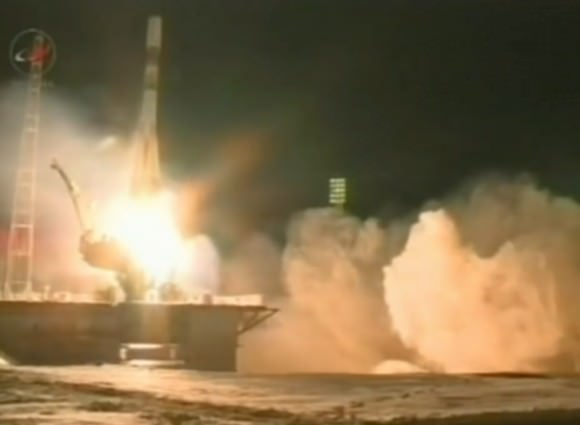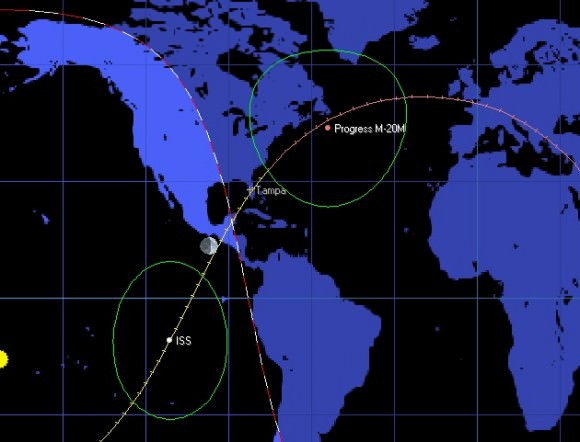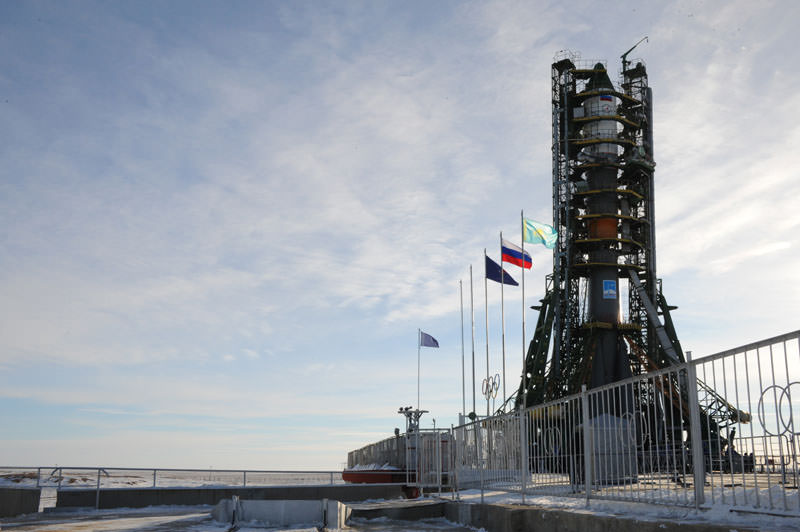Live streaming video by Ustream
The first launch of February 2014 worldwide is about to light up the night skies over the Baikonur Cosmodrome in Kazakhstan, with the launch of a Soyuz-U rocket carrying the uncrewed Progress M-22M spacecraft to the ISS. You can watch the launch live here, as well as the “fast-track” docking just 5 hours and 58 minutes later.
Progress will be carrying 2.8 tons of fuel, oxygen, supplies and experiments to the International Space Station. This will be the 54th Progress flight to the International Space Station since the first Progress launch to the station in 2000.
The launch is set to occur at 16:23:33 Universal Time or 11:23:33 AM EST. NASA TV will go live with the launch at 11:00 AM EST/16:00 UT, and TV Tsenki will also broadcast video from the pad just prior, though the broadcast frequently its sans audio.
Progress is also on a four orbit “fast-track” launch headed to the International Space Station. Tune in to NASA TV at 5:00 PM EST/22:00 UT later today, and you’ll be able to catch the docking of the Progress spacecraft to the Pirs module of the ISS as well. Docking is set to occur at 5:25 PM EST/22:25 UT over the North Atlantic Ocean.
Fun fact: Neil Armstrong still holds the record for the fastest journey from liftoff to docking at 5 hours and 33 minutes during Gemini 8 way back in 1966.
Update: ISS Astros indeed report during the live broadcast of the launch of Progress M-22M on NASA TV today of catching sight of the first stage of the Soyuz-U at liftoff… we’ll post any pics if and when they surface.
Progress M-20M undocked from the same Pirs compartment earlier this week on Monday in order to make way for the arrival of Progress M-22M. Progress M-20M is still in orbit, and is slated for a fiery destructive reentry on February 11th over the South Pacific. The long span between undocking and reentry for Progress M-20M allows for experiments on the spacecraft’s attitude control system to be carried out by ground controllers.

This also marks the start of a busy 2014 season at the International Space Station. On March 1st, SpaceX continues its contract to resupply the station with the launch of a Falcon 9 rocket with its fifth Dragon capsule making its third operational delivery to the station on CRS-3. Then later in March on the 12th, Expedition 38 crewmembers Oleg Kotov, Sergey Ryazansky, and NASA astronaut Michael Hopkins will return to Earth aboard Soyuz TMA-10M. The next crewed launch headed to the International Space Station are Expedition 39 cosmonauts Alexander Skvortsov, Oleg Artemyev, and NASA astronaut Steve Swanson launching from Baikonur on March 26th on Soyuz TMA-12M.
Progress M-22M is ultimately slated to undock from the Pirs module of the International Space Station on April 7th for a destructive reentry over the South Pacific. Three additional SpaceX launches utilizing Dragon capsules and two more launches of Orbital Science’s Cygnus cargo spacecraft will be conducted in 2014, as well as visits by the European Space Agency’s ATV-5 Georges Lemaitre in June and JAXA’s HTV-5 in July.
And another launch from the Baikonur Cosmodrome is coming right up on Valentine’s Day, February 14th, with the liftoff of an International Launch Services Proton rocket carrying the Turksat 4A satellite. The launch will be carried live via the ILS website and is slated for 21:09 UT/4:09 PM EST.
And though these are all standard resupply missions to the International Space Station, spaceflight is anything but routine. Avid trackers of live launches will remember the Progress M-12M spacecraft that was lost shortly after launch back in August 2011. To date, Progress M-12M was the only supply craft that failed to reach the International Space Station. Progress M-12M impacted in the Choisk Region of Russia’s Altai Republic in the Far East. The RD-0110 engine began to experience a flight anomaly just over five minutes after launch, causing the flight computer to execute a termination of thrust. Progress M-12M was the first loss of a Progress spacecraft since the start of the program in 1978. Ironically, Progress M-12M carried among its cargo manifest 10 paintings made by the son of Russian artist Alesandr Shilov said to be for “the psychological support of the crew…” There’s also a small cottage industry in Siberia east of Russian launch sites in salvaging rocket parts and boosters for scrap metal as they plummet from the sky.

It’s also possible to spot these spacecraft from your backyard as they arrive and depart from the International Space Station. We caught sight of Progress M-20M just last night, passing very near the waxing crescent Moon. Progress was about magnitude +1 when directly overhead, and was about 9 minutes ahead of the International Space Station. We’ve seen the Dragon, HTV, ATV spacecraft, as well as the U.S. Space Shuttle shortly after undocking from the International Space Station when it was in service. In fact, there’s a series of good passes of the ISS at dusk over the next few evenings for the southeastern United States, including a pass at ~6:58 PM EST tonight. Progress M-20M should be about 20 minutes ahead of the station at this point, assuming, of course, it hasn’t maneuvered in its orbit as a part of ongoing thruster control experiments.
We’ll be checking those final orbital corrections just prior to the pass tonight, as well as tracking the launch and docking of Progress M-22M. Follow us on Twitter (@Astroguyz) for further updates.
Be sure to catch all the action at Baikonur and in low Earth orbit today, both online and overhead!

